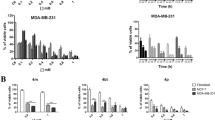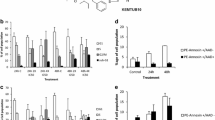Summary
Inhibitors of kinesin spindle protein Eg5 are characterized by pronounced antitumor activity. Our group has recently synthesized and screened a library of 1,3,4-thiadiazoline analogues with the pharmacophoric structure of K858, an Eg5 inhibitor. We herein report the effects of K858 on four different breast cancer cell lines: MCF7 (luminal A), BT474 (luminal B), SKBR3 (HER2 like) and MDA-MB231 (basal like). We demonstrated that K858 displayed anti-proliferative activity on every analyzed breast cancer cell line by inducing apoptosis. However, at the same time, we showed that K858 up-regulated survivin, an anti-apoptotic molecule. We then performed a negative regulation of survivin expression, with the utilization of wortmannin, an AKT inhibitor, and obtained a significant increase of K858-dependent apoptosis. These data demonstrate that K858 is a potent inhibitor of replication and induces apoptosis in breast tumor cells, independently from the tumor phenotype. This anti-proliferative response of tumor cells to K858 can be limited by the contemporaneous over-expression of survivin; consequently, the reduction of survivin levels, obtained with AKT inhibitors, can sensitize tumor cells to K858-induced apoptosis.






Similar content being viewed by others
References
Rath O, Kozielski F (2012) Kinesins and cancer. Nat Rev Cancer 12:527–539
Enos AP, Morris NR (1990) Mutation of a gene that encodes a kinesin-like protein blocks nuclear division in A. nidulans. Cell 60:1019–1027
Castillo A, Morse HC 3rd, Godfrey VL, Naeem R, Justice MJ (2007) Overexpression of Eg5 causes genomic instability and tumor formation in mice. Cancer Res 67:10138–10147
Mayer TU, Kapoor TM, Haggarty SJ, King RW, Schreiber SL, Mitchison TJ (1999) Small molecule inhibitor of mitotic spindle bipolarity identified in a phenotype-based screen. Science 286:971–974
Sarli V, Giannis A (2008) Targeting the kinesin spindle protein: basic principles and clinical implications. Clin Cancer Res 14:7583–7587
El-Nassan HB (2013) Advances in the discovery of kinesin spindle protein (Eg5) inhibitors as antitumor agents. Eur J Med Chem 62:614–631
Leizerman I, Avunie-Masala R, Elkabets M, Fich A, Gheber L (2004) Differential effects of monastrol in two human cell lines. Cell Mol Life Sci 61:2060–2070
Silkworth WT, Cimini D (2012) Transient defects of mitotic spindle geometry and chromosome segregation errors. Cell Div 7:19
Gasnereau I, Boissan M, Margall-Ducos G, Couchy G, Wendum D, Bourgain-Guglielmetti F, Desdouets C, Lacombe ML, Zucman-Rossi J, Sobczak-Thepot J (2012) KIF20A and its gene product MKlp2 are increased during hepatocyte proliferation and hepatocarcinogenesis. Am J Pathol 180:131–140
Muller C, Gross D, Sarli V, Gartner M, Giannis A, Bernhardt G, Buschauer A (2007) Inhibitors of kinesin Eg5: antiproliferative activity of monastrol analogues against human glioblastoma cells. Cancer Chemother Pharmacol 59:157–164
Xing ND, Ding ST, Saito R, Nishizawa K, Kobayashi T, Inoue T, Oishi S, Fujii N, Lv JJ, Ogawa O, Nishiyama H (2011) A potent chemotherapeutic strategy in prostate cancer: S-methoxytrityl-L-cysteine, a novel Eg5 inhibitor. Asian J Androl 13:236–241
Wojcik EJ, Buckley RS, Richard J, Liu L, Huckaba TM, Kim S (2013) Kinesin-5: cross-bridging mechanism to targeted clinical therapy. Gene 531:133–149
Mitchison TJ (2012) The proliferation rate paradox in antimitotic chemotherapy. MolBiol Cell 23:1–6
Lad L, Luo L, Carson JD, Wood KW, Hartman JJ, Copeland RA, Sakowicz R (2008) Mechanism of inhibition of human KSP by ispinesib. Biochemistry 47:3576–3385
Blagden SP, Molife LR, Seebaran A, Payne M, Reid AH, Protheroe AS, Vasist LS, Williams DD, Bowen C, Kathman SJ, Hodge JP, Dar MM, de Bono JS, Middleton MR (2008) A phase I trial of ispinesib, a kinesin spindle protein inhibitor, with docetaxel in patients with advanced solid tumours. Br J Cancer 98:894–899
Beer TM, Goldman B, Synold TW, Ryan CW, Vasist LS, Van Veldhuizen PJJ, Dakhil SR, Lara, PN Jr. , Drelichman A, Hussain MH, Crawford ED (2008) Southwest Oncology Group phase II study of ispinesib in androgen-independent prostate cancer previously treated with taxanes. Clin Genitourin Cancer 6: 103–109.
Sikov WM (2015) Assessing the role of platinum agents in aggressive breast cancers. Curr Oncol Rep 17:3
De Iuliis F, Taglieri L, Salerno G, Lanza R, Scarpa S (2015) Taxane induced neuropathy in patients affected by breast cancer: literature review. Crit Rev Oncol Hematol 96:34–45
Hershman DL, Weimer LH, Wang A, Kranwinkel G, Brafman L, Fuentes D, Awad D, Crew KD (2011) Association between patient reported outcomes and quantitative sensory tests for measuring long-term neurotoxicity in breast cancer survivors treated with adjuvant paclitaxel chemotherapy. Breast Cancer Res Treat 125:767–774
Marcus AI, Peters U, Thomas SL, Garret S, Zelnak A, Kapoor TM, Giannakakou P (2005) Mitotic inhibitors induce mitotic arrest and cell death in Taxol-resistant and sensitive cancer cells. J Biol Chem 280:11569–11577
De Monte C, Carradori S, Secci D, D'Ascenzio M, Guglielmi P, Mollica A, Morrone S, Scarpa S, Aglianò AM, Giantulli S, Silvestri I (2015) Synthesis and pharmacological screening of a large library of 1,3,4-thiadiazolines as innovative therapeutic tools for the treatment of prostate cancer and melanoma. Eur J Med Chem 105:245–262
Nakai R, Iida S, Takahashi T, Tsujita T, Okamoto S, Takada C, Akasaka K, Ichikawa S, Ishida H, Kusaka H, Akinaga S, Murakata C, Honda S, Nitta M, Saya H, Yamashita Y (2009) K858, a novel inhibitor of mitotic kinesin Eg5 and antitumor agent, induces cell death in cancer cells. Cancer Res 69:3901–3909
De Iuliis F, Salerno G, Giuffrida A, Milana B, Taglieri L, Rubinacci G, Giantulli S, Terella F, Silvestri I, Scarpa S (2015) Breast cancer cells respond differently to docetaxel depending on their phenotype and on survivin upregulation. Tumor Biol. doi:10.1007/s13277-015-4075-x
Asraf H, Avunie-Masala R, Hershfinkel M, Gheber L (2015) Mitotic slippage and expression of survivin are linked to differential sensitivity of human cancer cell-lines to the kinesin-5 inhibitor monastrol. PLoS One 10:e0129255
Asanuma H, Torigoe T, Kamiguchi K, Hirohashi Y, Ohmura T, Hirata K, Sato M, Sato N (2005) Survivin expression is regulated by coexpression of human epidermal growth factor receptor2 and epidermal growth factor receptor via phosphatidylinositol 3-kinase/AKT signaling pathway in breast cancer cells. Cancer Res 65:11018–11025
Wang H, Lu C, Li Q, Xie J, Chen T, Tan Y, Wu C, Jiang J (2014) The role of kif4A in doxorubicin-induced apoptosis in breast cancer cells. Mol Cells 37:812–818
Li Y, Lu W, Chen D, Boohaker RJ, Zhai L, Padmalayam I, Wennerberg K, Xu B, Zhang W (2015) KIFC1 is a novel potential therapeutic target for breast cancer. Cancer Biol Ther 16:1316–1322
Purcell JW, Davis J, Reddy M, Martin S, Samayoa K, Vo H, Thomsen K, Bean P, Kuo WL, Ziyad S, Billig J, Feiler HS, Gray JW, Wood KW, Cases S (2010) Activity of the kinesis spindle protein inhibitor ispinesib (SB-715992) in models of breast cancer. Clin Cancer Res 16:566–576
Gomez HL, Philco M, Pimentel P, Kiyan M, Monsalvo ML, Conlan MG, Saikali KG, Chen MM, Seroogy JJ, Wolff AA, Escandon RD (2012) Phase I dose-escalation and pharmacokinetic study of ispinesib, a kinesin spindle protein inhibitor, administered on days 1 and 15 of a 28-day schedule in patients with no prior treatment for advanced breast cancer. Anti-Cancer Drugs 23:335–341
Guido BC, Ramos LM, Nolasco DO, Nobrega CC, Andrade BY, Pic-Taylor A, Neto BA, Corrêa JR (2015) Impact of kinesin Eg5 inhibition by 3,4-dihydropyrimidin-2 (1H)-one derivatives on various breast cancer cell features. BMC Cancer 15:283
Lens SM, Wolthuis RM, Klompmaker R, Kauw J, Agami R, Brummelkamp T, Kops G, Medema RH (2003) Survivin is required for a sustained spindle checkpoint arrest in response to lack of tension. Embo J 22:2934–2347
Lv YG, Yu F, Yao Q, Chen JH, Wang L (2010) The role of survivin in diagnosis, prognosis and treatment of breast cancer. J Thorac Dis 2:100–110
Siddiqa A, Long LM, Li L, Marciniak RA, Kazhdan I (2008) Expression of HER-2 in MCF-7 breast cancer cells modulates anti-apoptotic protein survivin and bcl-2 via the extracellular signal-related kinase (ERK) and phosphoinositide-3 kinase (PI3K) signaling pathways. BMC Cancer 8:129
Lo Russo PM, Goncalves PH, Casetta L, Carter JA, Litwiler K, Roseberry D, Rush S, Schreiber J, Simmons HM, Ptaszynski M, Sausville EA (2015) First in human phase 1 study of filanesib, a kinesis spindle protein inhibitor, in patients with advanced solid tumors. Investig New Drugs 33:440–449
Author information
Authors and Affiliations
Corresponding author
Ethics declarations
Conflict of interest
The authors declare that they have no conflict of interest.
Rights and permissions
About this article
Cite this article
De Iuliis, F., Taglieri, L., Salerno, G. et al. The kinesin Eg5 inhibitor K858 induces apoptosis but also survivin-related chemoresistance in breast cancer cells. Invest New Drugs 34, 399–406 (2016). https://doi.org/10.1007/s10637-016-0345-8
Received:
Accepted:
Published:
Issue Date:
DOI: https://doi.org/10.1007/s10637-016-0345-8




